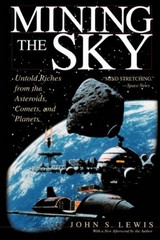 A long, long time ago, in a galaxy we are all familiar with, asteroids rained all the gold, cobalt, iron, manganese, nickel,osmium, molybdenum, palladium, rhenuim, rhodium, ruthenium and tungsten that we will ever mine from this planet, onto the earth’s crust.
A long, long time ago, in a galaxy we are all familiar with, asteroids rained all the gold, cobalt, iron, manganese, nickel,osmium, molybdenum, palladium, rhenuim, rhodium, ruthenium and tungsten that we will ever mine from this planet, onto the earth’s crust.
Based on known earthly reserves and growing rates of consumption in developing countries, it has been speculated that metal reserves essential for modern industry, including antimony, zinc, tin, silver, indium, gold and copper, could be depleted from Earth within the next 50-60 years.
For the above two reasons alone, I am willing to bet that international space exploration is about to take off. Why? Because at the rate we’re going, in a few years, you will no longer be able to look down for metals: you’ll have to look up. Space exploration is going to expand fiercely and rapidly because there is going to be an exceedingly practical reason for it that is far more interesting to most of us than pure science: namely, competition, and huge amounts of potential profits. Soon, we will be going to go back to the source for metal resources – and that will take us into outer space, into a fantastically interesting subject known as asteroid mining.
Near-earth asteroids are considered the most immediate likely candidates for asteroid mining. At 1997 prices, a small metallic asteroid no wider than 1 mile across was calculated to contain more than $20 trillion worth industrial and precious metals– so at today’s prices, it would be even significantly more than that. As another point of comparison, a 1 km-wide asteroid would probably contain more than 2 billion metric tons of iron-nickel ore, which would be more than twice the global annual production of iron ore in 2004. That doesn’t even include whatever precious metals it would also contain.
Apparently, there are three different ways of mining asteroids:
1. Bringing back raw material from the asteroid for processing on earth;
2. Processing the asteroidal materials on-site, thus reducing transportation costs and possibly even producing fuel propellant from the raw materials for the trip home; or (my favorite):
3. Dragging the entire asteroid to a safe orbit around the moon or Earth, so that the majority of its materials can be used and not wasted. It looks like pretty much all you need to know about asteroid retrieval methods, or “catching”, can be found in this handy Wikipedia link: Methods for asteroid retrieval or catching . Although probably a tad on the expensive side, it could be a far more interesting weekend hobby than fishing. At the very least, it brings new meaning to the idea of a pet rock.
What is interesting to note is that, although it is conceded that the cost of asteroid retrieval still outweighs their market value and that at current commodity prices and space transportation costs it is not expected to attract private investment, it doesn’t say anywhere that the technology needed to do this doesn’t exist. In other words, it can be done. And even if you or I can’t afford it right at this moment, it will be done. If you decide to get serious about this, it seems that all you need to know about the subject is available on Wikipedia. And remember, when the headlines about asteroid retrieval start circulating more regularly, you can say you heard about it right here, on the C Marshall Fabrication Machinery website blog, first.
-Anja Wulf
